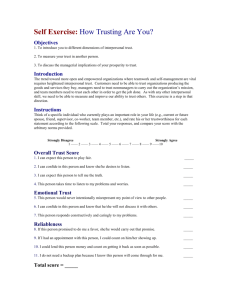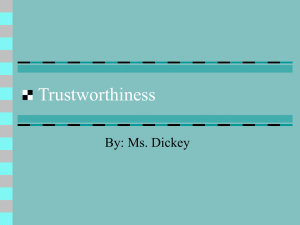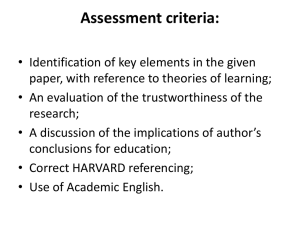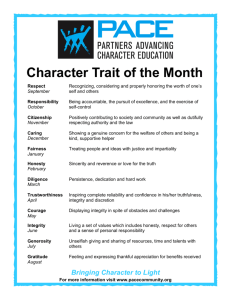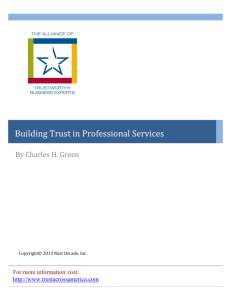TIIM2011_FP-Häkkinen
advertisement
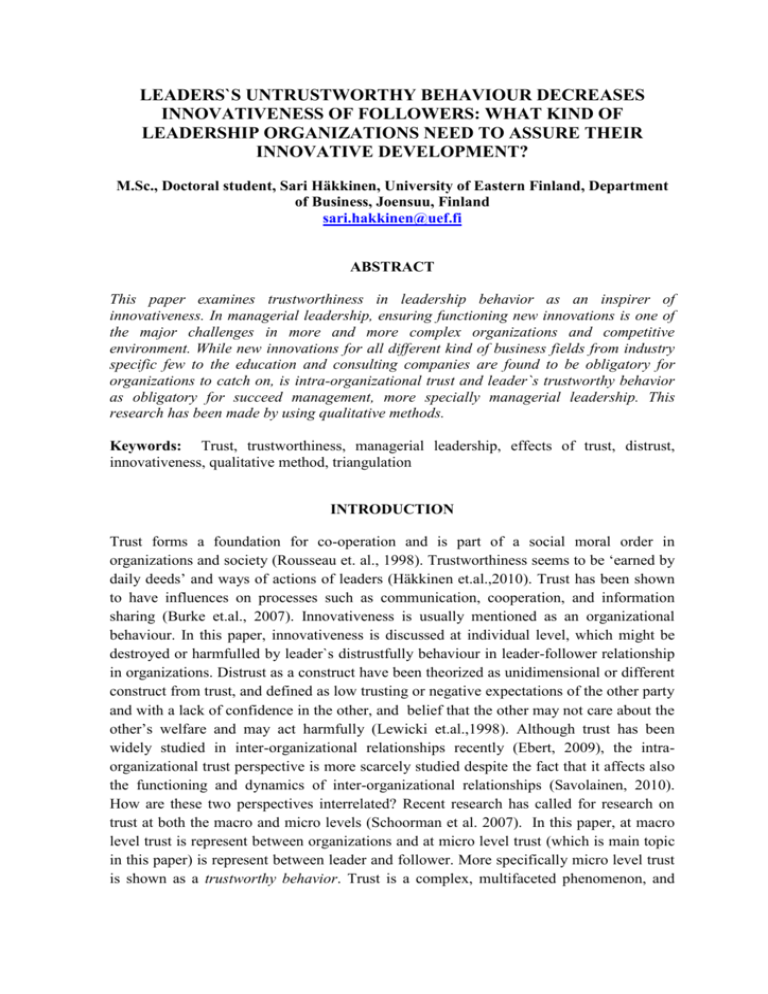
LEADERS`S UNTRUSTWORTHY BEHAVIOUR DECREASES INNOVATIVENESS OF FOLLOWERS: WHAT KIND OF LEADERSHIP ORGANIZATIONS NEED TO ASSURE THEIR INNOVATIVE DEVELOPMENT? M.Sc., Doctoral student, Sari Häkkinen, University of Eastern Finland, Department of Business, Joensuu, Finland sari.hakkinen@uef.fi ABSTRACT This paper examines trustworthiness in leadership behavior as an inspirer of innovativeness. In managerial leadership, ensuring functioning new innovations is one of the major challenges in more and more complex organizations and competitive environment. While new innovations for all different kind of business fields from industry specific few to the education and consulting companies are found to be obligatory for organizations to catch on, is intra-organizational trust and leader`s trustworthy behavior as obligatory for succeed management, more specially managerial leadership. This research has been made by using qualitative methods. Keywords: Trust, trustworthiness, managerial leadership, effects of trust, distrust, innovativeness, qualitative method, triangulation INTRODUCTION Trust forms a foundation for co-operation and is part of a social moral order in organizations and society (Rousseau et. al., 1998). Trustworthiness seems to be ‘earned by daily deeds’ and ways of actions of leaders (Häkkinen et.al.,2010). Trust has been shown to have influences on processes such as communication, cooperation, and information sharing (Burke et.al., 2007). Innovativeness is usually mentioned as an organizational behaviour. In this paper, innovativeness is discussed at individual level, which might be destroyed or harmfulled by leader`s distrustfully behaviour in leader-follower relationship in organizations. Distrust as a construct have been theorized as unidimensional or different construct from trust, and defined as low trusting or negative expectations of the other party and with a lack of confidence in the other, and belief that the other may not care about the other’s welfare and may act harmfully (Lewicki et.al.,1998). Although trust has been widely studied in inter-organizational relationships recently (Ebert, 2009), the intraorganizational trust perspective is more scarcely studied despite the fact that it affects also the functioning and dynamics of inter-organizational relationships (Savolainen, 2010). How are these two perspectives interrelated? Recent research has called for research on trust at both the macro and micro levels (Schoorman et al. 2007). In this paper, at macro level trust is represent between organizations and at micro level trust (which is main topic in this paper) is represent between leader and follower. More specifically micro level trust is shown as a trustworthy behavior. Trust is a complex, multifaceted phenomenon, and different conceptualizations of the nature of trust exist in interpersonal relations (Möllering et.al.,2004). Leaders show trustworthiness by building and sustaining or violating trust (Häkkinen et.al., 2010). The effects of leader trustworthiness are presented and discussed based on two real life cases from small industrial companies. Both companies represented different kind of leadership styles; other might be describes democratic and the other authoritarian. In conclusion, the findings confirm the results in prior trust research that leader’s competence (ability) is one of the key dimensions of trustworthiness (Peterson,1998) as well as leadership style. Findings show that the process of trust development is complex appearing as more meandering in nature. Tillmar (2007) conceptualizes trust and distrust as the endpoints of a continuum. Research results indicate, that when distrust exists between leader and follower, the follower has no interest to create new or develop itself or its work neither than feel innovative. Trust might also imagine as a “house with many doors”, when it is possible to open a new door and going forward ignoring the disappointments; moving on. I might hesitate how far human might go without breaking down and giving up to even try to trust anymore? Every door you open, that heavier it will be to open the second one. The study also shows that leadership style makes difference to innovative atmosphere at the organization. The style of management-by-fear broke the opportunities for developing and keeping quality and innovative workforce (Savolainen & Häkkinen,2011). Distrusting employees do not work effectively and share their knowledge, and tacit knowledge in specific (Savolainen,2008), which is extremely harmful for innovativeness atmosphere in organizations. Methodologically this qualitative research is implemented by using triangulation. Narrative analysis, interviews and observation methods are combined in the study. Qualitative research methods have challenged to trustworthy development and leadership influences for subordinates and organizations (Cho & Ringquist,2007). THEORETICAL DISCUSSION Trust, Distrust and Trustworthiness Trust has been classified in business research as an intra-organizational trust and an extraorganizational trust. Trust in different organizational and business relationships has been examined widely and multidisciplinary over the last few years (Ebert, 2009). Inter- and intra-organizational trust has been seen as a basis for all relationships and business interactions. Rotter (1967) defines interpersonal trust as an expectancy by an individual or a group that the word or promise (verbal or written) of another individual or group can be relied upon. The importance of trust in leadership within organizational contexts has been recognized in the literature. Trust has been shown to have influences on processes such as communication, cooperation, and information sharing (Burke et.al, 2007, cf. Shamir& Lapidot, 2003). Distrust as a construct have been theorized as unidimensional or different construct from trust, and defined as low trusting or negative expectations of the other party and with a lack of confidence in the other, and belief that the other may not care about the other’s welfare and may act harmfully (Lewicki et.al, 2006, 1998). Trust has been seen as a one of the main element of productivity in organizations (Bijlsma & Koopman 2003). In continuous change occurring in organizations, trust plays an important role in improving work welfare and business success (Seretin 2005, Mishra 1996). Innovativeness and good work welfare are walking hand-by-hand. Commitment to work and organization, and mental well-being are related affecting the success of the organization. In this trust plays also a role (Coyle-Shapiro et. al., 2002). Commitment of employees is shown in acceptance of company values, pursuing goal achievement, and pride of working in the organization and willingness to stay (Coyle-Shapiro et. al., 2002). Trust appears at many levels, organizational or managerial, and is manifested in interaction between employees and/or organization (Joseph & Winston 2005, Serva, Fuller & Mayer 2005). At the organizational level trust is described as faith in the engagements of the employer. Employees believe that the actions of organizations are performed for public interests eventually (Lee 2004, Gilbert & Tang 1998). The more engaged followers are their work, that better they share their knowledge and innovative ideas to company`s credit. Mental insecurity may be often a reason for atmosphere- related problems in workplaces such as teasing, conflicts, disputes and arguing. All of them affect the level of trust. Mental well-being is largely sustained by emotional support (appreciation, respect, openness, feedback, etc). Correlation of commitment for work and organization is reflected in employees work motivation and satisfaction, i.e., work welfare (Häkkinen, 2007). Leaders support is expected and their actions are seen as the most influential. In co-creation, trust is a basic element of functioning relationships in organizations (Savolainen, 2008). Employees in organizations create trustworthiness by their actions and behavior. Trust building has been listed as one of the most essential tasks in managerial leadership (Graen & Uhl-Bien 1995, Yukl 2010). Trust building and maintaining is complex, however (Ikonen & Savolainen 2010, Nurmio & Turkki 2010). Leader traits and behavior including styles and skills matter in trust building. By implication leaders mundane behavior seems to play the main role, i.e., trust is built and maintained by leaders ‘daily deeds’ (Häkkinen & Savolainen, 2010, Savolainen, 2009). Theoretically, various leader traits and leadership styles are related to trustworthiness shown in practice by the leader’s behavior in dyadic subordinate-leader relationship. In conclusion, trustworthiness matters in emergent leadership (cf. Yukl,2010). Managerial leadership and innovativeness Theoretically, various leader traits and leadership styles are related to trustworthiness shown in practice by the leader’s behavior in dyadic subordinate-leader relationship. In conclusion, trustworthiness matters in emergent leadership (cf. Yukl,2010). Leadership, management and managerial leadership, couching leadership etc., are often mixed metaphors. Northouse (2004) descriptive leadership as to explain how leaders help organizations to reach their purposes through concern for production (which is generally named as a management) and concern for people (leadership). Additional confusion for the term leadership is caused by the use of other imprecise terms as power, authority, management, administration, control and supervision to describe similar phenomena (cf. Yukl, 2010). Leadership includes following concepts: other term is management, reference to the past and future, dealing with change and managing stability, symbol of responsible and power, and also process of influence. Managerial leadership retains both terms: management and leadership, which means that processes and people will be lead at the same time. (Avery, 2004) Innovative leadership or leading innovativeness retains those dimensions of leadership and for that reason, could be understood as a managerial leadership point of view. In the development of trust and distrust in the organization, organizational culture is depicted as ‘the other side of the coin of leadership’ and is largely influenced by leaders’ actions (Schein, 2004). In the case of very authoritarian management style, for example, employees become socialized into and adopt the way of actions of their leaders. As an indication of trustworthiness, trustful atmosphere, spontaneous sociality emerges between organization members (Fairholm & Fairholm, 1999). In the opposite case, distrustful atmosphere prevails which hinders communication and interaction (Savolainen & Häkkinen, 2010). Poor leadership underestimates employees’ competences, which destroys innovativeness. RESEARCH METHODOLOGY AND DATA Methods of analysis This paper adopts an explorative, qualitative approach to the study of trustworthiness within leadership. In the study, interviews, observation and narrative methods are used. The data were collected by means of thematic face-to-face interviews, open-ended interviews and observations. A few team leader-follower dyads in two organizations have been interviewed and observed. Methodologically, and from the philosophy of science perspective, this qualitative study is based on the constructionist paradigm and multisource data. Narrative analysis, method of narrative accounts as well as interviews and observations will be combined in the study. Qualitative research methods have challenged the studying of trustworthy development and leadership influence on subordinates and organizations (Cho & Ringquist 2007). This paper answers the challenge by qualitative and longitudinal type of study using several data gathering methods. Description of case company Both companies are SMS companies and well recognized on their own business field and economically bandwagon. New innovations and product development were obligatory to the lean manufacturer. - Company A, the first case (thesis) company, manufacturing and sale of valves and pumps, operating in worldwide. - Company B, the second company, vegetable food supplier which main customers include mostly professionals in food, restaurant and catering companies in Finland. Company A- The leadership style was pretty authentic and organization composition very hierarchy. Middle managers had responsibility, but it was somewhat apparent; GM made all decisions after all and his behavior was not steady handed nor neutral or equitable toward employees. Open dialogue between managers and subordinates was not potential. Also fear and qualm for GM`s attitude existed among the people. Co-creation between employees through the organization was insignificant. Company B- The leadership style was democratic and participative management. Atmosphere in the organization was communicative and open to debate. Flexible job descriptions provided for diverse work and limitation of liability as well as authority. Cocreation between employees and managers was trivial and matter of course. Main findings The study shows that the factors most influential to the trust between leader and follower are: First leader: 1) equal behavior toward all employees and avoid divide or separate them for groups. Also avoid create too close relationship between any subordinates. 2) Showing and being trustworthiness when behaving stabile all the time, standing behind the values and leading democratic. 3) encourage followers to share their knowledge by asking their opinions and respecting their points of view. Second follower: 1) Avoid group together modeling cliques or clans inside the work community. 2) Distinguish work from leisure when adopting attitude for co-workers and leaders; understand the relevant behavior at work. 3) Share their knowledge to all co-workers and let information flow for tacit knowledge. Furthermore, the study suggests that the most important phases influencing the strengthening of trust are reciprocity between an employer and an employee, competence of both parties and increasing of responsibility. On the contrary, at the organizational level, trust is not necessarily mutual and reciprocal (Schoorman et al. 2007). In other words, leader trustworthy behavior and untrustworthy behavior has effects on the organizational level trust. (Savolainen & Häkkinen, 2010) CONCLUSIONS In conclusion, the trustworthy behavior by subordinates might implement work related behavior and high commitment for company and work. Conclusively it can be stated that perceptions of the dyadic leader-subordinate trust about each other’s ability, integrity and benevolence has effect on the extent to which an organization can be trusted (Schoorman et al. 2007). Thus, it seems that organizational and inter-personal trust are inter-related. Based on the research results, it seems evident that trust cannot be build without continuous interaction with leaders and followers, which has reciprocal effect on the interpersonal and organizational level trust, which is obligatory for people`s commitment and free will to create new and share their knowledge for benefiting organization. Overall, the study increases understanding of trustworthiness in leader behavior, leadership style and the consequences of trustworthy and untrustworthy behavior at both interpersonal and organizational levels. The two leaders make an illustrative case for untrustworthy and trustworthy leadership reflected in different kinds of leadership features and behaviors. Most importantly, the differences in the cases show the favorable and unfavorable effects of trust in showing trustworthiness; in the first case trustful climate with enthusiasm, high commitment and effective communication and knowledge sharing prevail. In the second case, distrustful atmosphere, fear, low commitment, and lack of collaboration activity, and knowledge sharing appear respectively. As to leader behavior, in the case of authoritarian management style, employees become socialized into and adopt the very way of actions of their leader. Culture develops with unwritten daily manners by the influence of the leader. Lack of respect and appreciation stimulates development of distrust (Fairholm & Fairholm, 1999). The study implies that managers should learn more of trust and develop behavioral skills for showing trustworthiness. This way they may become more conscious of the role and consequences of trust and distrust in their actions of leadership. The style of management-by-fear broke the opportunities for developing and keeping quality workforce (Peterson, 1998). Distrusting employees do not work effectively and share their knowledge, and tacit knowledge in specific (Savolainen, 2008; Juuti, 1999). REFERENCES 1. Avery., G.C., 2004. Understanding Leadership. Sage Publications Ltd. London. 2. Cho, Y. J., Ringquist, E. Trustworthiness, Leadership, and Organizational Performance: A Longitudinal Analysis. Prepared for the 9th National Public Management Research Conference of Public Management Research Association, Tucson, AZ, October 25-27, 2007. 3. Coyle-Shapiro, J. A-M., Morrow. P. C., Richardson. R., Dunn. S. R., 2002. “Using Prifit Sharing To Enhance Employee Attitudes: A Longitudinal Examination of the Effects on Trust and Commitment”. Human Resource Management. Vol. 41(4):423-439. 4. Bijlsma, K. & Koopman, P. 2003. Introduction: trust within organizations. Personnel Review 32 (5), 543-555. 5. Burke, C. S., Sims, D.E., Lazzara E.H.; Salas, E. 2007. Trust in leadership: A multilevel review and integration. The Leadership Quarterly 18: 606–632. 6. Ebert, T.A.E. 2009. Facets of Trust in Relationships – A Literature Synthesis of Highly Ranked Trust Articles. Journal of Business Management 3, 65-84. 7. Fairholm, M. R. & Fairholm, G. 2000. Leadership amid the constrains of trust. Leadership & Organization Development Journal 21 (2), pp. 102–109. 8. Häkkinen, S., Ikonen, M. & Savolainen, T. 2010. Do Leaders Expressions of Emotions Build Trustworthiness? Proceedings of the ISLC Conference. Lund University, Sweden, December 13-14, 2010. 9. Lewicki, McAllister, D., Bies, R. 1998. Trust and distrust: New relationships and realities. Academy of Management Review 23: 439-458. 10. Möllering, G. , Bachmann, R. Lee, S. H. 2004.Understanding organizational trust – foundations, onstellations, and issues of operationalisations. Journal of Managerial Psychology, Vol. 19No. 3 pp.556-570.6. Peterson. R., 1998. Trust for quality. The TQM Magazine. Vol. 10 (6): 413-416. 11. Northouse, P. G., 2004. Leadership Theory and Practice. Sage Publications Inc. California. 12. Nurmio, A. & Turkki, T. (Eds.) 2010. Report Vital Finland. (Raportti Elinvoimainen Suomi). Helsinki: Suomen itsenäisyyden juhlarahasto Sitra. (In Finnish) 13. Peterson. R., 1998. Trust for quality. The TQM Magazine. Vol. 10 (6): 413-416. 14. Rousseau, D., Sitkin, S., Burt, R. Camerer, C. 1998. Not so different after all: a crossdescipline view of trust. Academy of Management Review, Vol. 23, No. 3. (July 1998) pp. 393-404. 15. Savolainen, T. 2008. Sharing tacit knowledge in a project-based organization: Perspective of trust. In:Proceedings of the 13th ICPQR, International Conference on Productivity and Quality Research, 25-27 June,2008. Kujala, J. & Iskanius, P. (Eds), University of Oulu, Finland (in CD.). 16. Savolainen, T. & Häkkinen, S. 2011. Towards new leadership by trust: Leader’s trustworthiness makes a difference to co-creation. Proceedings of the 10th EBRF International Conference 15-17.9.2010, Nokia, Finland. 17. Savolainen, T. 2010.Role of trust in managing customer focus: Multilevel empirical and theoretical issues. In Proceedings of the 5th EIASM Workshop on Trust Within and Between Organizations, January 28-29, 2010, Madrid, Spain. Electronic publ. (CD), 19 pp. 18. Schoorman, F.D., Mayer, R.C. & Davis, J.H. 2007. An integrative model of organizational trust: Past, present, and future. Academy of Management Review, Vol. 32, No. 2, 344-354. 19. Shamir, B. & Lapidot, Y. 2003. Trust in Organizational Superiors: Systemic and Collective Considerations. Organization Studies 24(3): 463 – 491 20. Serva, M.A., Fuller, M.A. & Mayer, R.C. 2005. The reciprocal nature of trust: a longitudinal study of interacting teams. Journal of Organizational Behavior 26, 625648 21. Tillmar, M. 2009. No Longer So Strange? (Dis)Trust in Municipality–Small Business Relationships. Economic and Industrial Democracy, Vol. 30, No 3, 401-428. 22. Yukl 2010. Leadership in Organizations. 10th ed. Prentice Hall.
